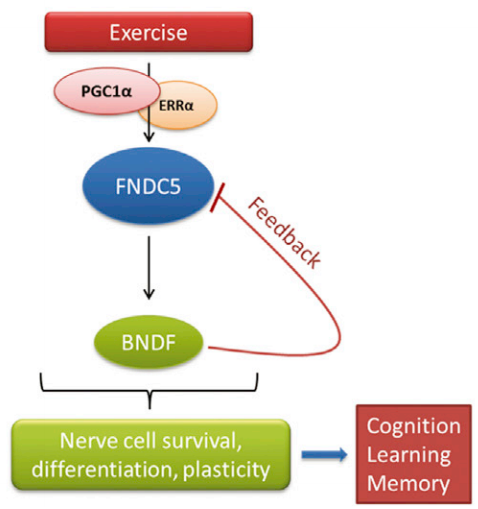How exercise boosts brain health
October 14, 2013
[+]
Research has shown that exercise is good for the brain. Now investigators have identified a molecule called irisin that is produced in the brain during endurance exercise and has neuroprotective effects.
Exercise
stimulates increased BDNF gene expression. BDNF is the master regulator
of nerve-cell survival, differentiation, and plasticity in the brain.
This will lead to improved cognitive function, learning, and memory.
(Credit: Christiane D. Wrann et al., Cell Metabolism)
Researchers were able to artificially increase the levels of irisin in the blood to activate genes involved in learning and memory. The findings may be useful for designing drugs that use this exercise-induced molecule to guard against neurodegenerative diseases and improve cognition in the aging population.
While it’s known that exercise can boost cognitive function and lessen symptoms of neurological diseases like depression, stroke, and Alzheimer’s disease, the mechanisms underlying these effects have been unclear. One important player is thought to be a growth factor named brain-derived neurotrophic factor (BDNF).
Through experiments conducted in mice, investigators led by Dr. Bruce Spiegelman of the Dana-Farber Cancer Institute and Harvard Medical School found that a molecule called FNDC5 and its cleavage product, irisin, are elevated by endurance exercise in the brain and increase BDNF expression. On the other hand, mice genetically altered to have low irisin levels in the brain had reduced levels of BDNF.
The team also found that raising levels of irisin in the circulation caused the molecule to cross the blood brain barrier, where it increased expression of BDNF and activated genes involved in cognition.
“Our results indicate that FNDC5/irisin has the ability to control a very important neuroprotective pathway in the brain,” says Spiegelman. The researchers next plan to work on developing a stable form of the irisin protein that can be given to mice by injection and may augment the brain’s natural anti-degeneration pathways.
Abstract of Cell Metabolism paper
Exercise can improve cognitive function and has been linked to the increased expression of brain-derived neurotrophic factor (BDNF). However, the underlying molecular mechanisms driving the elevation of this neurotrophin remain unknown. Here we show that FNDC5, a previously identified muscle protein that is induced in exercise and is cleaved and secreted as irisin, is also elevated by endurance exercise in the hippocampus of mice. Neuronal Fndc5 gene expression is regulated by PGC-1α, and Pgc1a−/− mice show reduced Fndc5 expression in the brain. Forced expression of FNDC5 in primary cortical neurons increases Bdnf expression, whereas RNAi-mediated knockdown of FNDC5 reduces Bdnf. Importantly, peripheral delivery of FNDC5 to the liver via adenoviral vectors, resulting in elevated blood irisin, induces expression of Bdnf and other neuroprotective genes in the hippocampus. Taken together, our findings link endurance exercise and the important metabolic mediators, PGC-1α and FNDC5, with BDNF expression in the brain.
(¯`*• Global Source and/or more resources at http://goo.gl/zvSV7 │ www.Future-Observatory.blogspot.com and on LinkeIn Group's "Becoming Aware of the Futures" at http://goo.gl/8qKBbK │ @SciCzar │ Point of Contact: www.linkedin.com/in/AndresAgostini
 Washington
Washington